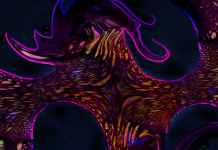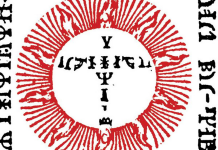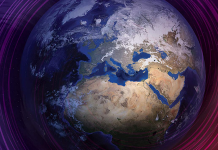 A spiritual path is, among other things, a way of seeing the world. That is to say, a spiritual path is a way of understanding or interpreting our relationships with the many things, events, people, and places in the world. In most cases, the path will be expressed or configured by a logic of correspondences. In accord with this logic, the appearance of a certain animal, or plant, or weather event, or whatever, signifies realities beyond itself. Similarly, every spiritual path will have meditations, rituals, techniques, practices, and so on, designed to help the practitioner recognise those signs and read the messages they convey.
A spiritual path is, among other things, a way of seeing the world. That is to say, a spiritual path is a way of understanding or interpreting our relationships with the many things, events, people, and places in the world. In most cases, the path will be expressed or configured by a logic of correspondences. In accord with this logic, the appearance of a certain animal, or plant, or weather event, or whatever, signifies realities beyond itself. Similarly, every spiritual path will have meditations, rituals, techniques, practices, and so on, designed to help the practitioner recognise those signs and read the messages they convey.
The co-ordinates of the correspondences will vary in accord with language, culture, climate, geography, and other factors. They can grow ever more complicated and intricate, in order to accommodate an ever growing range of things and events in an ever-changing world. The associations of the four classical elements to cardinal directions, colours, ritual objects, seasons of the year, times of day, and so on, are well known examples. Yet the logic of correspondence can appear in things as simple as children’s rhymes. The game of counting crows: “One for sorrow, two for joy, three for a girl and four for a boy,” and so on, is also a logic of magical correspondences.
This isn’t big news to those who study religion, and certainly not new to anyone who studies occultism or esoterica. But there is at least one set of correspondences that tend not to be mentioned very often, even though it is staring us all in the face. Implicit in every logic of correspondence there is also a logic of ethics. Very few writers in occultism and esoterica draw much attention to the ethical dimension of the correspondences. I find this surprising since, that dimension appears everywhere.
The tarot names three of the four classical virtues in its major arcana: Strength (a.k.a. Courage), Justice, and Temperance. Only Prudence is missing: but perhaps prudence is implied in the figures of the Emperor and Empress, the enlightened rulers of a just and prosperous society. For that matter, the tarot includes teachers of ethics, such as the Heirophant and the High Priestess, and it offers models of knowledgeable and enlightened people, such as the Empress, and the Hermit. And it offers in the figure of the Fool the seeker himself, who like each of us, once in a while, may think himself wise, but knows not how he is about to step off a cliff. (Of course, the tarot also offers a teacher in the form of that other fellow, fifteenth in line for the throne. But even this guy implies the very ethical concepts he appears to subvert.) The minor arcana can be read as the model of a well ordered feudal society, with its kings and queens at the top, its nobility in the knights and pages, and in the numbered cards its population of farm workers, craftspeople, artists, merchants, soldiers, and village idiots.
The kabballist Tree of Life is similarly loaded with ethical ideas. The first thing that the student is taught about the diagram is that there are two pillars holding up the arch over a door to a temple. These pillars are named for ethical categories: severity, on the left, and mercy, on the right. Furthermore, there is a middle pillar, the on which uppermost sphere is called Kether, the Crown, and the lowermost is called Malkuth, the Kingdom. These too are social and political categories. In the 19th century, the philosopher Ludwig Feuerbach argued that religion is only the projection on to the cosmos of human qualities and values.1 To a great extent the Tree of Life is an excellent example of his point, for it is a model of a human social order, a model of absolute monarchy to be specific, described as the structure of the mind of God himself.
One finds ethical concepts appearing in the correspondences of astrology as well. In Nicholas Campion’s study of astrology in the history of ideas, there is a reproduction of a sixteenth century wood engraving which depicts the structure of the universe, as the mediaeval Christian world view saw it.2 People still believed in the Ptolemaic model back then: therefore the heavenly bodies are fixed to concentric circles with the Earth in the centre. The image also connects each circle, and hence each planet, with a social value. The correspondences offered in this image are as follows:
| Centre circle | the Earth | Justice |
| Second | the Moon | Truth |
| Third | Mercury | Fecundity |
| Fourth | Venus | Mercy |
| Fifth | the Sun | Religion |
| Sixth | Mars | Strength |
| Seventh | Jupiter | Prudence |
| Eighth | Saturn | Majesty |
In the ninth circle, the realm of pure Being, beyond the vault of the outer stars, the woodcut depicts an image of Queen Elisabeth I herself. The image as a whole is an esoteric model of the cosmos, and at the same time a spectacular piece of political propaganda. Its purpose, after all, is to assert that the government of the Tudor dynasty is as stable and eternal and perfect as the heavens themselves. Therefore, so the message goes, to question or to rebel against the dynasty is as futile and irrational as rebelling against the rising of the sun in the morning. This is another instance of Feuerbach’s point about the projection of human values on to the cosmos, and I’m sure that was the very purpose of the woodcut. Contemporary astrologers are still doing the same work, although with much more subtlety. For each zodiac sign, each planet, each house, and each angle of relationship among them, is a representation of a mode of human life. That premise is implied in the very notion that astrology can teach us anything at all about our personalities, prospects, and potentials.
I suspect that all the professional astrologers among my friends are dialling my phone number right now. They might say that ethical concepts, as they appear in esoteric material like the tarot, kabbalah, and astrology, should be understood as moments in the internal life of a spiritual seeker. They are relevant only to the personal development of the seeker as she pursues greater knowledge of the divine, or of the psychic planes of higher reality which configure this world. Or they should be understood as psychic or cosmic forces which configure human life, not the other way around, as Feuerbach argued. It might be pointed out that some people seek magick precisely to escape the repression and absurdity of some of the moral standards that our wider society accepts. But my point is simple: the vocabulary of ethics pervades the logic of spiritual correspondences everywhere, even in occultism and esoterica. Therefore, as uncomfortable as it may be to admit, much of that material can support Feuerbach’s argument that religion is humanity’s narcissistic worship of its own social order as a totem.
Well, if we don’t like that prospect, what do we do about it? I think we should start by honestly facing up to it. But let us not treat it as the conclusion of a hostile outsider who would lock us all out of the temple. Let us see it as the problem of a concerned insider who wants more things to cross the threshold of the temple, and in both directions. Every spiritual tradition in the world teaches ethical values through its system of correspondences. There is simply no such thing as a spiritual tradition which says nothing about how we are to live. For we do not approach the sacred merely to learn the nature of things. We also approach the sacred to learn what to do. Every spiritual path therefore includes teachings about how to act, how to choose, and how to live. The logic of correspondences will offer associations of spiritual events with ethical principles for precisely this reason.
I think that if we courageously admit this fact, we will find there is nothing necessarily nefarious in it. And we will be in less danger of mindless overbearing dogmatism. I have given much of my life these last few years to working out this very problem. My own spiritual path, which began as Irish Druidry but now has evolved into something so weird that I should probably give it a new name, recognises three broad groups of ethical values. They are:
- The virtues of Wonder, which include enquiry, curiosity, imagination, and a sense of magic;
- The virtues of Humanity, which include respect, generosity, friendship, and love;
- The virtues of Integrity, which include honour, courage, perseverance, and proper pride.
In my understanding (explained in much greater detail in my latest book!), these values emerge from a seeker’s dialogue with an Immensity. It might be the Earth itself, the planet we all share. It might be a friend, a neighbour, a family member, even a complete stranger on a downtown street. It might be something more abstract, like transience, fate and destiny, and human mortality. But whatever it is, I believe the meeting place with it always has ethical significance. It is the place where choices and responses are called for. At the same time it is the place where our powers and potentials are put to the test. It is not the mere appearance of an Immensity which makes us spiritual. Rather, we are made spiritual by our response to it. In this way, the occasions in life that call for ethical choices to be made can also be occasions of spiritual discovery.
First published on Plutonica.net 23 June 2008.
Image credit: Adam Campbell
- c.f. Feuerbach, “The Essence of Christianity,” first published 1851. [↩]
- c.f. Campion, “The Great Year,” Penguin Arkana 1994, pg. 340. [↩]








